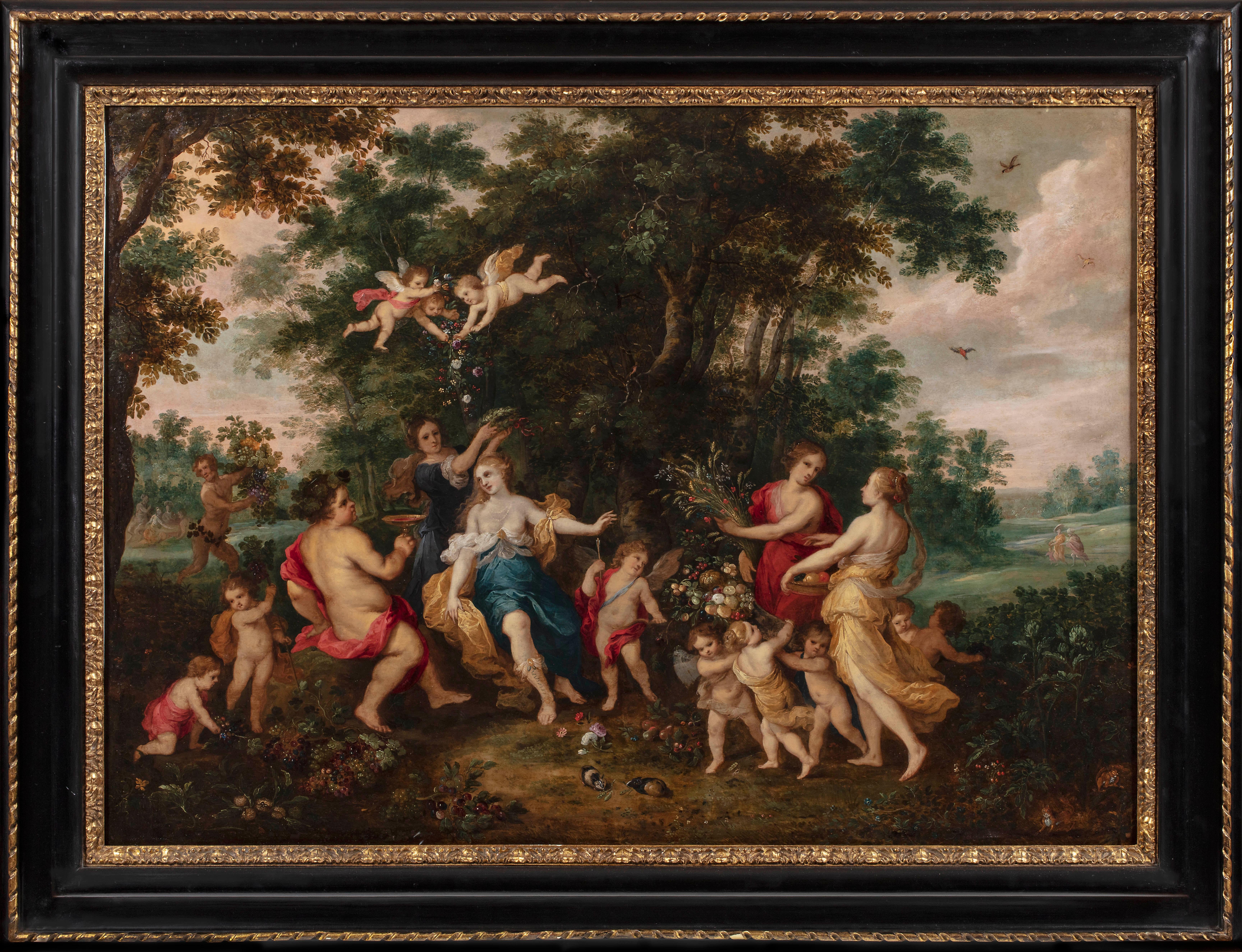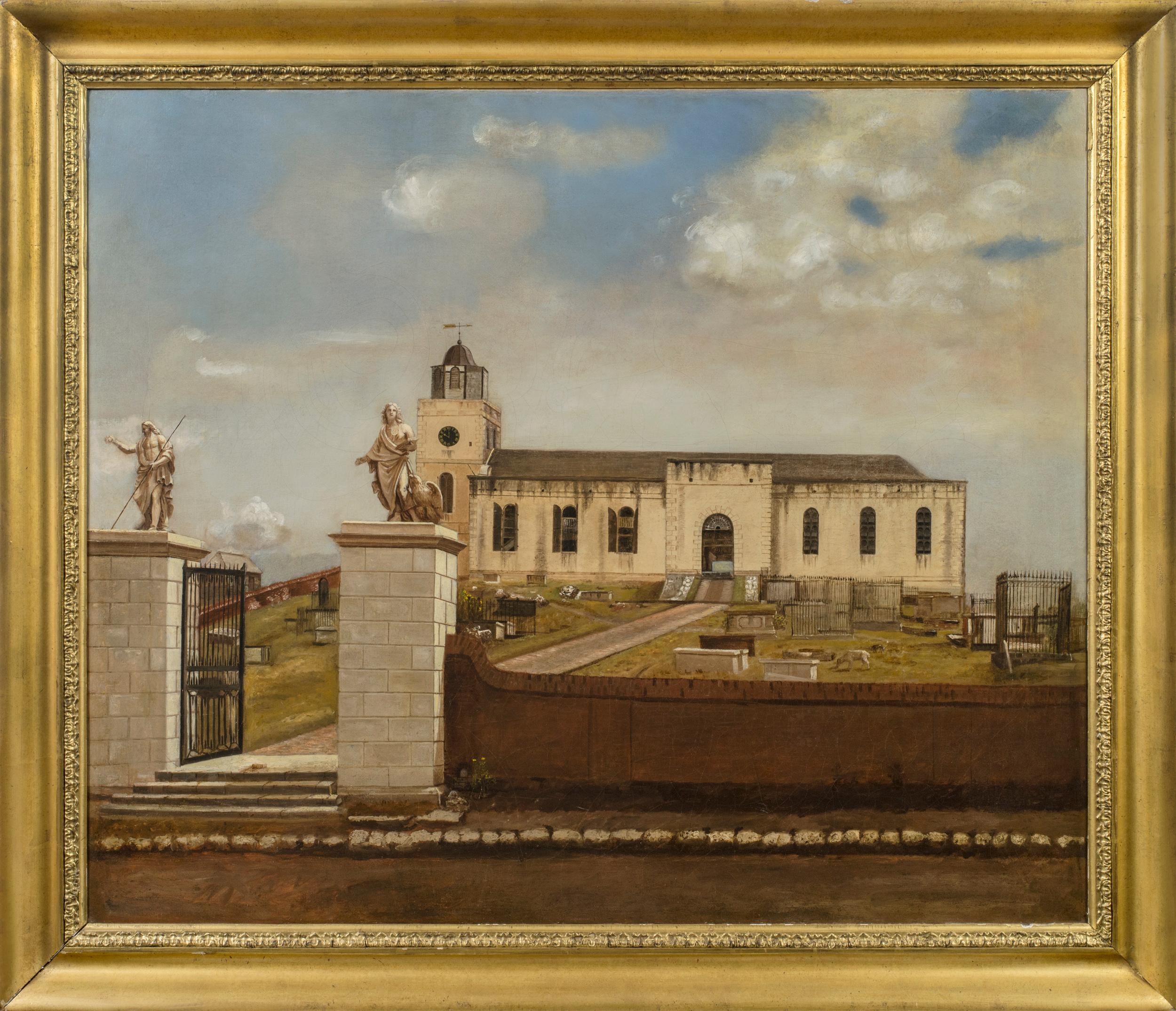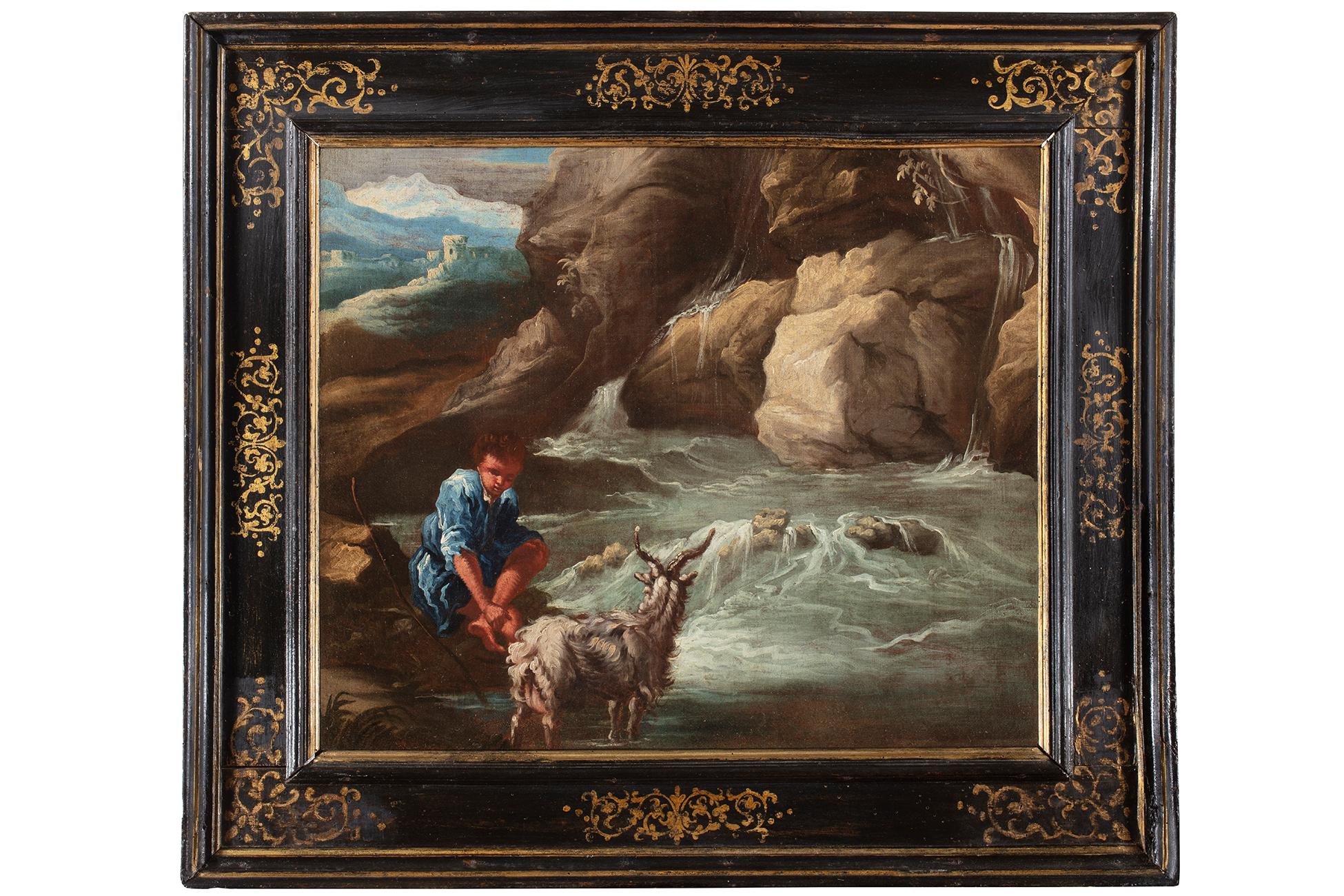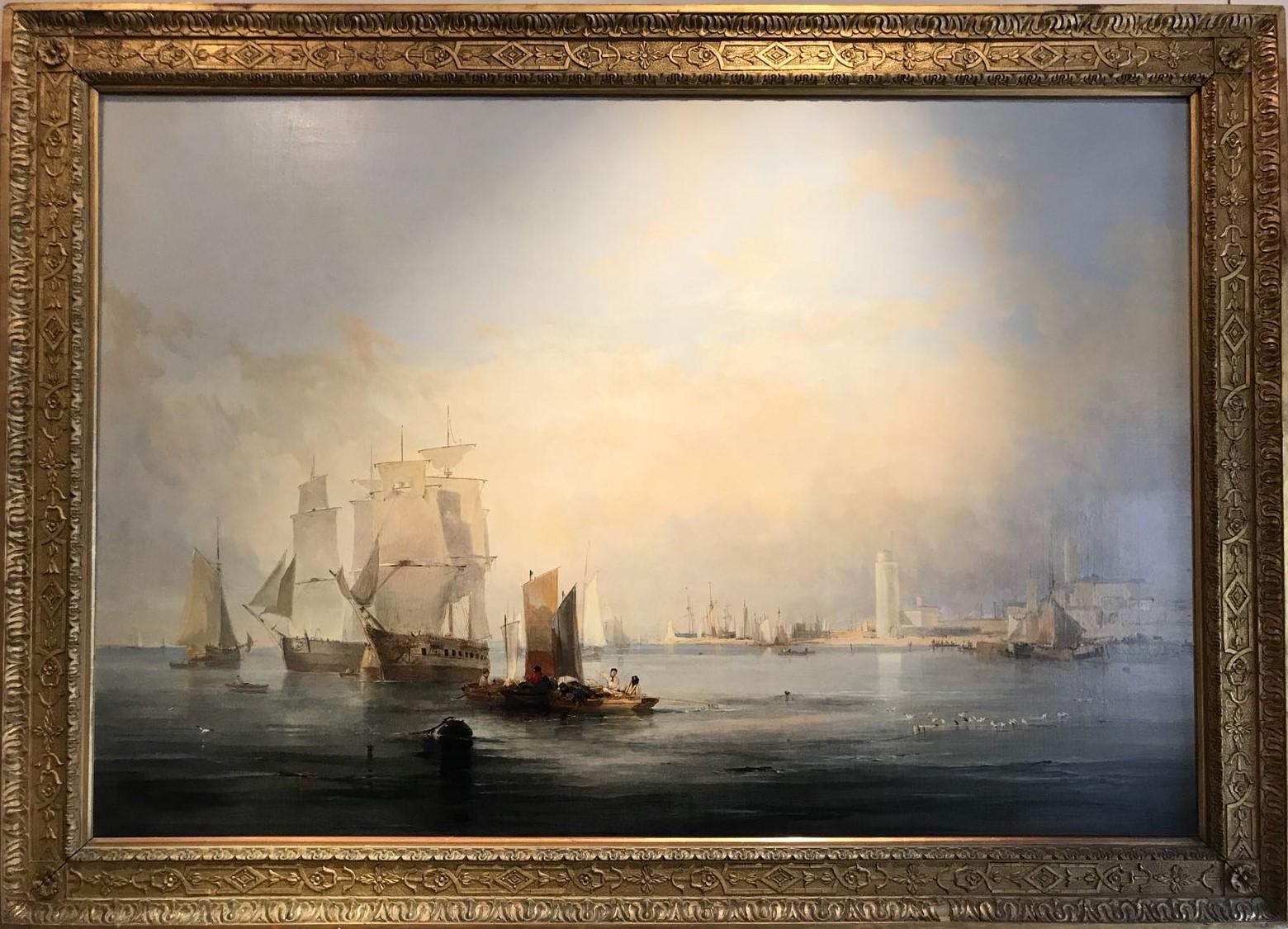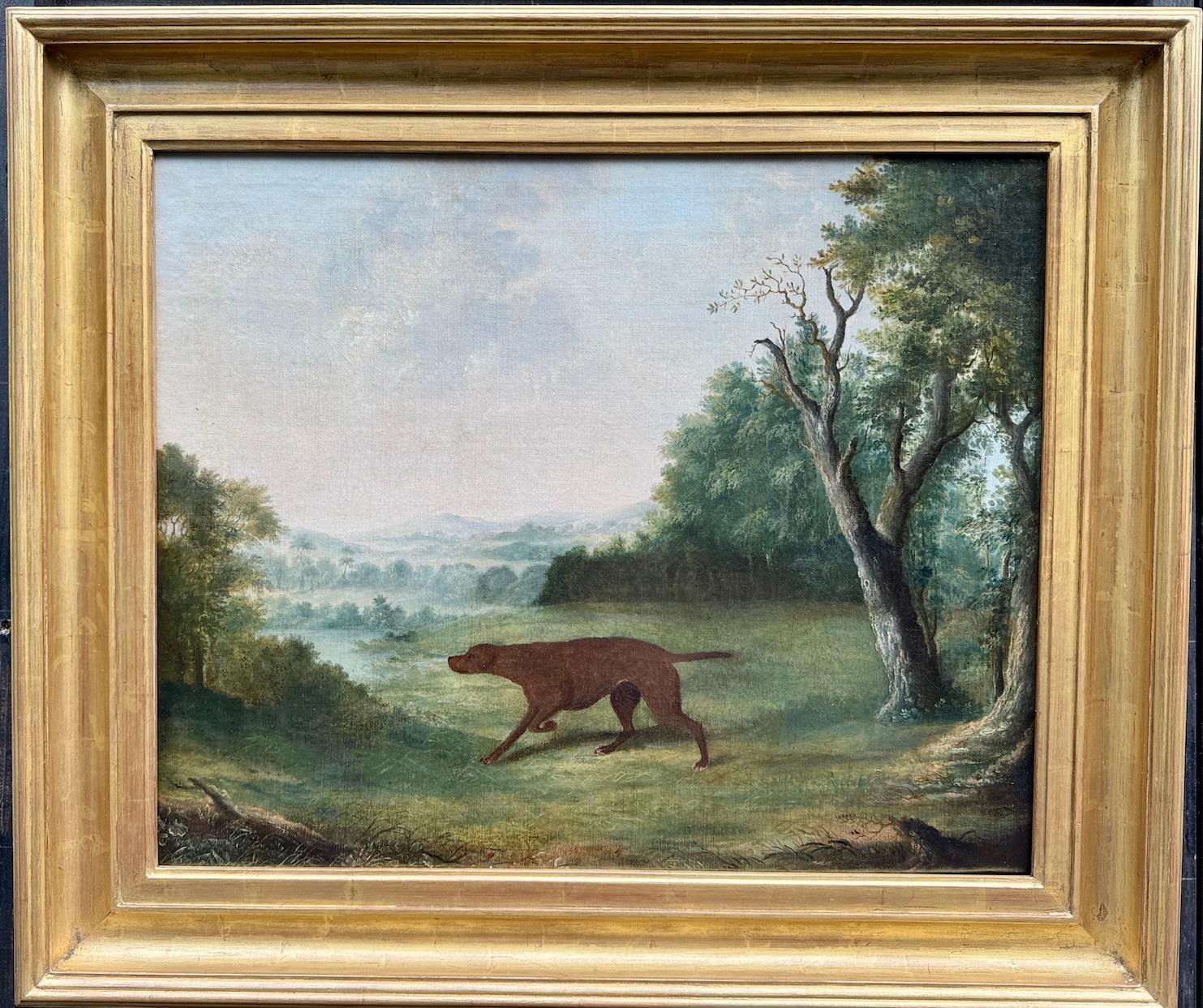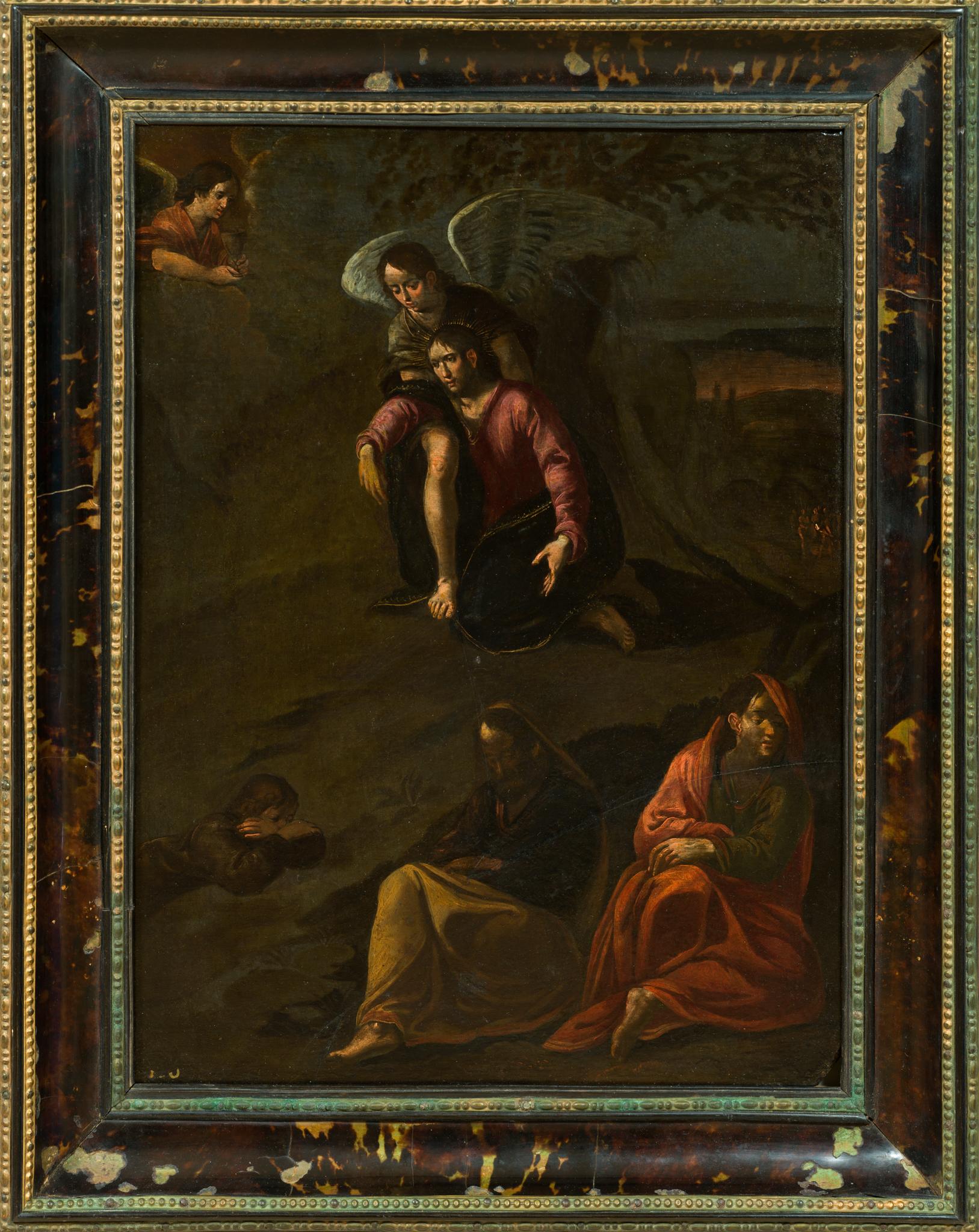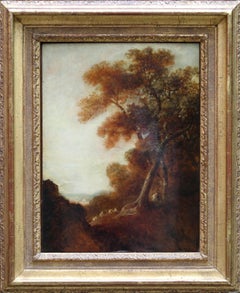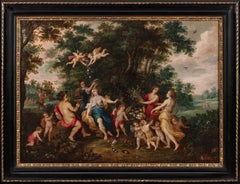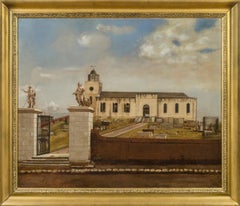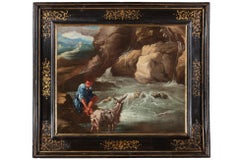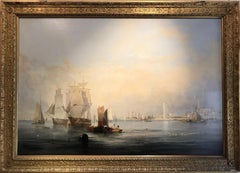Items Similar to Italian Arch - Old Master British art Italian landscape and ruins through arch
Want more images or videos?
Request additional images or videos from the seller
1 of 5
(Circle of) Hubert RobertItalian Arch - Old Master British art Italian landscape and ruins through archcirca 1890
circa 1890
About the Item
This lovely British 18th century landscape oil painting is attributed to circle of Hubert Robert or Robert of the Ruins as he was better known. The work depicts an extensive landscape as viewed through an arched building. Ivy and branches hang down the other side of the arch and columns can be seen to the left. The landscape disappears into the distance under a blue sky. A lovely painting typical of Hubert Robert in style and manner. In original untouched condition.
Provenance. Old auction chalk marks and old collectors red wax seal. Sussex estate.
Condition. Oil on canvas, 14 inches by 11 inches unframed. A bit thin in places.
Framed in an original ebonised period frame, 19 inches by 16 inches framed.
One of the most prominent artists of his era, Hubert Robert (1733-1808) is perhaps best known today as “Robert of the Ruins,” the nickname bestowed on him by the eighteenth-century philosopher, critic, and encyclopaedist Denis Diderot. Indeed, Robert loved and depicted ruined structures of all types, whether real or imagined, and not just those of ancient Rome (he lived in Italy for eleven years). He also drew inspiration from scenes he encountered in his native France, including urban renewal projects, Gallo-Roman antiquities, and natural disasters. At the core of his success was his brilliance as a master of the architectural capriccio, in which random monuments from different locales were artfully brought together to create new, completely imaginary landscapes.
In addition to being a talented landscape painter, Robert was a gifted and prolific draftsman, an engaging printmaker, an interior decorator, and a garden designer. Lively, intelligent, and much sought after, this good-humored, well-loved bon vivant moved easily through the most exalted circles of Paris’s society, even though his own parents had been personal attendants in an aristocratic household. He later addressed the demise of this glittering world through representations of contemporary events such as the vandalizing of royalist monuments and the destruction of the Bastille prison during the French Revolution. Imprisoned himself, he narrowly escaped the guillotine and upon his release completed a series of meditative depictions of the newly created Musée du Louvre, where he served as curator until his death in 1808.
- Creator:(Circle of) Hubert Robert (1733 - 1808, British)
- Creation Year:circa 1890
- Dimensions:Height: 19 in (48.26 cm)Width: 16 in (40.64 cm)Depth: 2 in (5.08 cm)
- Medium:
- Movement & Style:
- Period:
- Condition:
- Gallery Location:London, GB
- Reference Number:1stDibs: LU853113014852
About the Seller
5.0
Platinum Seller
Premium sellers with a 4.7+ rating and 24-hour response times
1stDibs seller since 2018
446 sales on 1stDibs
Typical response time: <1 hour
- ShippingRetrieving quote...Shipping from: London, United Kingdom
- Return Policy
Authenticity Guarantee
In the unlikely event there’s an issue with an item’s authenticity, contact us within 1 year for a full refund. DetailsMoney-Back Guarantee
If your item is not as described, is damaged in transit, or does not arrive, contact us within 7 days for a full refund. Details24-Hour Cancellation
You have a 24-hour grace period in which to reconsider your purchase, with no questions asked.Vetted Professional Sellers
Our world-class sellers must adhere to strict standards for service and quality, maintaining the integrity of our listings.Price-Match Guarantee
If you find that a seller listed the same item for a lower price elsewhere, we’ll match it.Trusted Global Delivery
Our best-in-class carrier network provides specialized shipping options worldwide, including custom delivery.More From This Seller
View AllMorning Landscape - British 1800 Royal Academy Exh Old Master art oil painting
Located in London, GB
This charming British Old Master exhibited landscape oil painting is by noted artist John Rathbone. It was painted in 1800 and exhibited at the Royal Academy London the same year so ...
Category
1890s Old Masters Landscape Paintings
Materials
Oil
Figures and Cattle on Woodland Path - French figurative landscape oil painting
By Philippe Budelot
Located in London, GB
This charming French Old Master oil painting is by noted French artist Philippe Budelot. Painted circa 1800 the composition is of figures on a woodland path by a lake. In the foreground is a drover on horseback with some cattle and a goat. They are being greeted by the sheep dog of the shepherdess behind them who has sheep scattered amongst the trees. More figures are coming along the path in the distance. The group in the foreground are well illuminated beneath the blue sky above and it is probably early morning. The brushwork on the trees is superb and the whole scene is quite charming. This is an excellent example of a French Old Master landscape...
Category
Early 1800s Old Masters Landscape Paintings
Materials
Oil
Ships Heading to Sea - Dutch 17th century Old Master marine art oil painting
Located in London, GB
This fantastic Dutch Old Master marine oil painting is by noted Dutch marine artist Abraham Storck. Painted circa 1670 the composition is a number of ships heading out to sea, their sails billowing and banners and flags blowing in the wind. The sea is also choppy and clouds race over head. It is an ambitious, busy nautical scene and Storck has perfectly captured the energy and movement of the ships and smaller vessels. This is an excellent example of a 17th century Dutch Old Master oil painting.
Provenance: Part of a private collection of Flemish & European paintings.
Koller Auctions in Switzerland in 2011.
Bonhams 2020.
Condition. Oil on canvas, 25 inches by 24 inches and in good condition.
Frame. Housed in an ornate 23 carat gilt carved Lely period frame with name plate, 32 inches by 31 inches and in excellent condition.
Abraham Storck (1644-1708) was a Dutch painter, who enjoyed a reputation for his marine paintings, topographical views and Italianate harbour scenes. Storck was also an outstanding draughtsman. Storck was baptized in the Noorderkerk, a Protestant church in the Jordaan. His father was the painter Jan Jansz Sturck (or Johannes Storck) (1603-1673), from Wesel; his mother was Teuntje (Apolonia) Jacobs. The couple married in 1628. Storck had two brothers, who were also painters using the name Sturckenburch until c. 1688 after which they started calling themselves Storck or Sturck. It is likely they were all trained with their father in the family workshop and joined the local Guild of Saint Luke, otherwise it was impossible to sell any painting. Circa 1666 Storck established his workshop producing naval, harbor scenes as well as landscape paintings and city scapes. In 1670 he traveled with his brother Jacob and worked in Germany. In 1694, at age 49, he married the widow Neeltje Pieters van Meyservelt. At the end of his life he lived on Kattenburg near the harbour. Storck's marine and river scenes were influenced by the two Willem van de Veldes (the elder and the younger), Ludolf Bakhuizen...
Category
1670s Old Masters Landscape Paintings
Materials
Oil
Wooded Landscape - British art 18thC Old Master oil painting trees figures
By Thomas Gainsborough (circle)
Located in London, GB
A delightful painting, oil on paper laid on panel, with beautiful Gainsboresque colouring. This is a fine Old Master circa 1770 landscape in the 18th century Romantic landscape tradi...
Category
18th Century Old Masters Landscape Paintings
Materials
Oil
Cattle and Drover in a Landscape - British Victorian art landscape oil painting
Located in London, GB
This gorgeous oil on canvas Victorian Old Master painting is by British artist Henry Jutsum. Painted circa 1850 the painting depicts a drover on horse back bringing up the rear behin...
Category
19th Century Old Masters Landscape Paintings
Materials
Oil
Italian Mountainous River Landscape - French 19th Century Neo Classical art
Located in London, GB
This stunning Neo Classical French 19th century landscape oil painting is by acclaimed French artist Jean Victor Bertin. He was also an early proponent of sketching out doors and dir...
Category
19th Century Old Masters Landscape Paintings
Materials
Oil
Jean Victor Bertin Italian Mountainous River Landscape - French 19th Century Neo Classical art, 1827
$81,329 Sale Price
20% Off
You May Also Like
Allegory of Abundance
Located in New York, NY
Painted in collaboration with Hendrick van Balen (Antwerp, 1575 – 1632).
Provenance: Private Collection, Uruguay, since the 1930s.
The eldest son of Jan Br...
Category
17th Century Old Masters Paintings
Materials
Copper
View of St. John’s Cathedral, Antigua
Located in New York, NY
Provenance:
Robert Hollberton, Antigua, ca. 1841
Private Collection, New York
The present painting depicts Old St. John’s Cathedral on the island of Antigua. The church was erected in the 1720s on the designs of the architect Robert Cullen. It measured 130 feet by 50 feet with north and south porches 23 x 20 ½ feet. The tower, 50 feet high with its cupola, was added in 1789. The church was elevated to the status of a cathedral, but disaster struck in the form of an earthquake that destroyed the building on 8 February 1843. A memorandum of that date relates the event:
“On Wednesday, 8th February, 1843, this island was visited by a most terrific and destructive earthquake. At twenty minutes before eleven o’clock in the forenoon, while the bell was ringing for prayers, and the venerable Robert Holberton was in the vestry-room, awaiting the arrival of persons to have their marriage solemnized, before the commencement of the morning service, the whole edifice, from one end to the other, was suddenly and violently agitated. Every one within the church, after the first shock, was compelled to escape for his life. The tower was rent from the top to the bottom; the north dial of the clock precipitated to the ground with a dreadful crash; the east parapet wall of the tower thrown upon the roof of the church; almost the whole of the north-west wall by the north gallery fell out in a mass; the north-east wall was protruded beyond the perpendicular; the altar-piece, the public monument erected to the memory of lord Lavington, and the private monuments, hearing the names of Kelsick, Warner, Otley, and Atkinson, fell down piecemeal inside; a large portion of the top of the east wall fell, and the whole of the south-east wall was precipitated into the churchyard, carrying along with it two of the cast-iron windows, while the other six remained projecting from the walls in which they had been originally inserted; a large pile of heavy cut stones and masses of brick fell down at the south and at the north doors; seven of the large frontpipes of the organ were thrown out by the violence of the shock, and many of the metal and wooden pipes within displaced; the massive basin of the font was tossed from the pedestal on which it rested, and pitched upon the pavement beneath uninjured. Thus, within the space of three minutes, this church was reduced to a pile of crumbling ruins; the walls that were left standing being rent in every part, the main roof only remaining sound, being supported by the hard wood pillars.”
The entrance from the southern side into the cathedral, which was erected in 1789, included two imposing statues, one of Saint John the Divine and the other of Saint John the Baptist in flowing robes. It is said that these statues were confiscated by the British Navy from the French ship HMS Temple in Martinique waters in 1756 during the Seven Years’ War and moved to the church. The statues are still in situ and can be seen today, much as they appeared in Bisbee’s painting, but with the new cathedral in the background (Fig. 1).
Little is known of the career of Ezra Bisbee. He was born in Sag Harbor, New York in 1808 and appears to have had a career as a political cartoonist and a printmaker. His handsome Portrait of President Andrew Jackson is dated 1833, and several political lithographs...
Category
19th Century Old Masters Landscape Paintings
Materials
Canvas, Oil
18th Century by Giuseppe Pianca Shepherd with Goat and River Oil on Canvas
Located in Milano, Lombardia
Giuseppe Antonio Pianca (Agnona di Borgosesia, Italy, 1703 - Milan, Italy, 1762)
Title: Shepherd with Goat and River
Medium: Oil on canvas
Dimensions: without frame 49 x 57 cm - wit...
Category
18th Century Old Masters Landscape Paintings
Materials
Canvas, Cotton Canvas, Oil
Grand 19th Century English Marine Painting in Stunning Light
By John Wilson Ewbank
Located in London, GB
John Wilson Ewbank (1799 - 1847)
Shipping in the Harbour, South Shields
Oil on canvas
39.5 x 58 inches unframed
47.75 x 66.5 inches framed
Provenance:
Christie's October 2002; Lot 11.
Fine Art Society;
Private Collection
This marvellous up to scale Ewbank is full of light and warmth and almost certainly his greatest work of the sort rarely - if ever - seen on the market.
John W. Ewbank (4 May 1799–28 November 1847), was an English-born landscape and marine painter largely operational from Scotland.
The Humber river is a large tidal estuary on the east coast of Northern England.
Life
Ewbank was born at Darlington on 4 May 1799, the son of Michael Ewbank, an innkeeper. He was adopted as a child by a wealthy uncle who lived at Wycliffe, on the banks of the River Tees, in the North Riding of Yorkshire. Intended for the Roman Catholic priesthood, he was sent to Ushaw College, from which he absconded.
In 1813 Ewbank was apprenticed to Thomas Coulson, an ornamental painter in Newcastle. In around 1816 he moved with Coulson to Edinburgh, where he had some lessons with Alexander Nasmyth. He found work both as a painter and a teacher. He was nominated in 1830 one of the foundation members of the Royal Scottish Academy.
In 1833 he is listed as living at 7 Union Street on the eastern fringe of the New Town in Edinburgh.
Works
His sketches from nature were especially admired, and a series of 51 drawings of Edinburgh by him were engraved by W. H. Lizars for James Browne's Picturesque Views of Edinburgh (1825). He also made a reputation with cabinet pictures of banks of rivers, coast scenes, and marine subjects.
As an illustrator he illustrated some early editions of Scott's Waverley Novels and one edition of Gilbert White...
Category
19th Century Old Masters Figurative Paintings
Materials
Oil
$197,902
Free Shipping
19th century English portrait of a Gun dog, hound in an English garden landscape
By George Stubbs
Located in Woodbury, CT
Follower of George Stubbs (British, 18th–early 19th century)
English Gun Dog in a Landscape, ca. 1800
Oil on canvas
Set against a serene English countryside, this striking portrait ...
Category
Early 1800s Old Masters Animal Paintings
Materials
Canvas, Oil
Christ Supported by an Angel in the Garden of Gethsemane, On Slate
Located in Stockholm, SE
This evocative Veronese School painting captures the moment in the Garden of Gethsemane when Christ, overwhelmed with sorrow, prays to God before his arrest and crucifixion. Supporte...
Category
Early 17th Century Old Masters Figurative Paintings
Materials
Slate
Recently Viewed
View AllMore Ways To Browse
Italian Old World
Antique Arch
Antique Arches
Antique Old World Art
Architectural Arch
Italian Seal
Arches Columns
18th Century French Landscape
Old Masters Attributed
Good Humor
Italian Ruins Painting
Italy Ruins Painting
Wax Seal Antique
Series Of Eleven
Antique Prison Art
Roman Ruins Painting
18th Ruins Painting
Italian Capriccio
